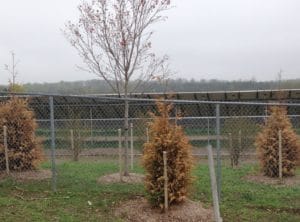Hello Fellow Readers,
Now that the tundra has melted away, the damage caused by our infinite winter has come to full view. For the first time, my evergreen shrubs were hammered by Bambi. Holy cow! Or should I say Holy Deer? I’m trying not to hold a grudge as the poor things were starving, and it’s nature’s way of pruning, I suppose.
Have you noticed many evergreens look as though they were scorched this winter? John from Stone Church asked what to do about the brownish-red dry foliage, which is much worse on one side of his young white pines.
About winter burn
The damage is called winter burn, caused by dehydrated plant tissues. When plants gather solar energy during photosynthesis, they release water. The process is called transpiration and results in moisture evaporation through the leaves and needles. When plants cannot replace lost water due to drought or deeply frozen ground, they will dehydrate. John’s one-sided dilemma is because the sunny side is where the sun’s rays intensify photosynthesis, causing more water loss.
While winter burn can cause death in severe cases, most likely, the impact is a foliar loss. Wait and see how your plants recover, I’d say until mid-June, and then prune back the dead stems. Meanwhile, fertilize and provide a light application of mulch around the roots to help conserve moisture. In severe cases, wait longer before determining if the plant is dead, but remove it before it attracts insects or disease.
Prevention from winter burn is best.
Like most problems, prevention is best. Stressed plants or planted too late in the season are especially susceptible. Winter burn is most severe when plants endure drying winds. Situate new plants out of windy zones and water them well as they establish, even during winter, when soil is not frozen. Some plants may benefit from burlap wrap, or consider erecting a windbreak to insulate them. There are anti-transpirant sprays, such as Wilt-pruf, often recommended. While most studies have shown them ineffective in preventing winter burn, I have successfully used them doing informal “trials” with Wilt-pruf and without.
Deer spray followed by an anti-transpirant plus being sure to avoid plant damage when tossing snow off the sidewalk (or roof!) makes for less winter damage: that, and plain old good luck.
Garden Dilemmas? AskMaryStone@gmail.com (and now on your favorite Podcast App.)
Column updated 12/22/22
Click through to learn more about Wilt-pruf.



